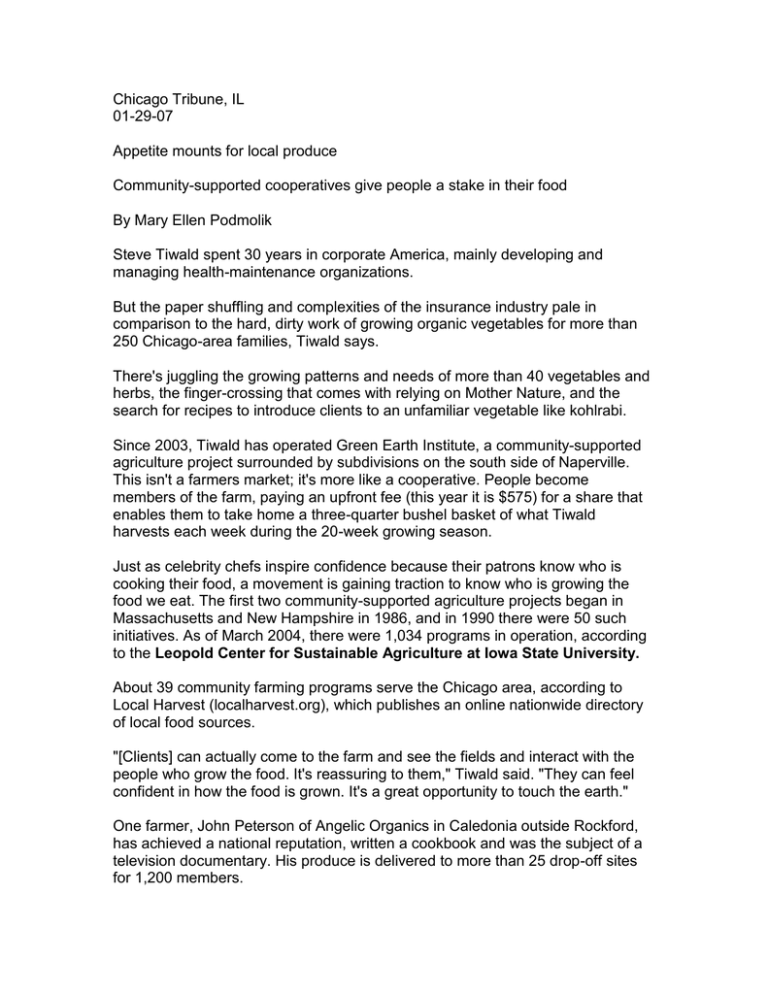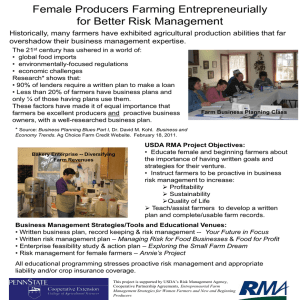Chicago Tribune, IL 01-29-07 Appetite mounts for local produce
advertisement

Chicago Tribune, IL 01-29-07 Appetite mounts for local produce Community-supported cooperatives give people a stake in their food By Mary Ellen Podmolik Steve Tiwald spent 30 years in corporate America, mainly developing and managing health-maintenance organizations. But the paper shuffling and complexities of the insurance industry pale in comparison to the hard, dirty work of growing organic vegetables for more than 250 Chicago-area families, Tiwald says. There's juggling the growing patterns and needs of more than 40 vegetables and herbs, the finger-crossing that comes with relying on Mother Nature, and the search for recipes to introduce clients to an unfamiliar vegetable like kohlrabi. Since 2003, Tiwald has operated Green Earth Institute, a community-supported agriculture project surrounded by subdivisions on the south side of Naperville. This isn't a farmers market; it's more like a cooperative. People become members of the farm, paying an upfront fee (this year it is $575) for a share that enables them to take home a three-quarter bushel basket of what Tiwald harvests each week during the 20-week growing season. Just as celebrity chefs inspire confidence because their patrons know who is cooking their food, a movement is gaining traction to know who is growing the food we eat. The first two community-supported agriculture projects began in Massachusetts and New Hampshire in 1986, and in 1990 there were 50 such initiatives. As of March 2004, there were 1,034 programs in operation, according to the Leopold Center for Sustainable Agriculture at Iowa State University. About 39 community farming programs serve the Chicago area, according to Local Harvest (localharvest.org), which publishes an online nationwide directory of local food sources. "[Clients] can actually come to the farm and see the fields and interact with the people who grow the food. It's reassuring to them," Tiwald said. "They can feel confident in how the food is grown. It's a great opportunity to touch the earth." One farmer, John Peterson of Angelic Organics in Caledonia outside Rockford, has achieved a national reputation, written a cookbook and was the subject of a television documentary. His produce is delivered to more than 25 drop-off sites for 1,200 members. Other area projects are seeing sizable interest as word spreads. Gray Wiechern works at Trader Joe's and last year grew produce on two acres and sold it at a local farmers market. But this year, she's forgoing the market and has established a community-supported project, Mother Earth Organic Farm in Plainfield, because she received so many requests. At Green Earth, Tiwald anticipates his membership base will grow to 325 in 2007. Accordingly, his acreage has increased, from 1 3/4 acres that he leased from a conservation foundation his first year to 8 acres this year. Growing Home, a 3-year-old Chicago project that primarily serves the city's North Side and Evanston, had 40 members in its first year, 55 members last year and expects to sign up 75 this year. The organization, which operates a farm in LaSalle County, recently trucked in composted soil and erected solar greenhouses houses on a vacant lot in Englewood with the hope of making its produce available year-round. "There's a huge demand for it that hasn't even come close" to being met, said Harry Rhodes, Growing Home's executive director. "At Whole Foods, it's organic, which is terrific, but you don't know where it's coming from." A study by the Leopold Center found that fresh domestic produce travels an average of 1,500 miles to reach Chicago. Another study found that Chilean grapes travel 17 days to arrive in Iowa. Recent food-safety scares, such as those involving Taco Bell, have people looking for alternatives. "There is a very strong connection here between this and health," said Richard Pirog, marketing and research systems program leader at Leopold. "If they know the farmer, the customer is satisfied with the handshake of the farmer who says no pesticides." The other benefit? "If there is a problem with the food, they know exactly who to go to," Pirog said. Joining a community-supported agriculture project means being willing to work a little harder to fill the refrigerator produce bins. Prices for shares of a project vary, as do the delivery methods. Some farmers crate the produce and drop off boxes at designated distribution points, while others require members to travel to the farm. Some projects also require members to volunteer a certain amount of hours at a farm. Acquiring new tastes In addition to the time and financial commitment, members also have to be ready to open their taste buds to new flavors. Farmers say while members excitedly wait for heirloom tomatoes to come in season, seeing a bunch of kale in their boxes frequently leaves people less than thrilled. Most farms publish weekly newsletters with recipes and cooking tips for the week's bounty. Wheaton resident Sue Gately isn't a big fan of broccoli, but she acknowledges the freshly harvested stalks taste better. And she was willing to give kohlrabi a try after she saw a little girl get excited about it while picking up her box at Green Earth. "It really builds a sense of community," Gately said. "You go through the line and talk to people [about] what are you doing with your kale and how you're preparing it." Still, she admits, "I swap kale for something else." Evanston resident Tim Squier and his wife, Kris, were drawn as much by the idea of fresh organic produce as they were by the social mission of Growing Home, which acts as a job-training program for homeless and low-income Chicago residents. This year, Squier has volunteered his front porch for one of the area drop-off points. Although he admits he had an overabundance of onions and beets last year, he also made some tasty discoveries, like arugula. "It introduced me to vegetables that I didn't even know existed," he said. Squier, who was introduced to the community-supported agriculture concept by a friend, has invited another friend this year to share a box. Despite the growing interest, the concept does have some drawbacks that are expected to eventually curb its growth. Weather, crop size factors One is simply the availability of produce in a region like the Midwest, and the fact that bad weather can water down a member's investment. There also is the accessibility factor: When you need a green pepper, it's more convenient to run to the local supermarket to buy it than wait to pick up your box the following week. For farmers, there are concerns about capital needs and the difficulty of securing loans for such an unconventional enterprise. And in a metropolitan area like Chicago, there is suburban sprawl and developers' quest for available land. In the Midwest, the average return per acre of a community-supported farm is $2,500, so most farmers either also hold other jobs or have spouses or partners who earn the bulk of the household income. "If you're a farmer on the outer ridges of Chicago's suburban sprawl and have the chance to sell your land, it might be a better deal to sell off," Pirog said.






